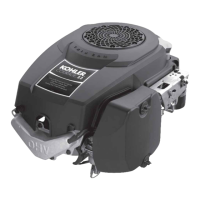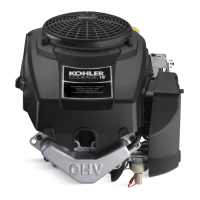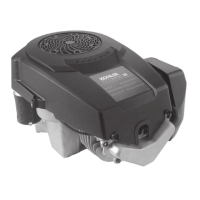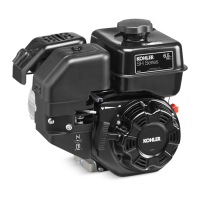9.7
Section 9
Inspection and Reconditioning
9
Valve Guides
If a valve guide is worn beyond specifications, it will
not guide the valve in a straight line. This may result
in burnt valve faces or seats, loss of compression, and
excessive oil consumption.
To check valve guide-to-valve stem clearance,
thoroughly clean the valve guide and, using a
split-ball gauge, measure the inside diameter of
the guide. Then, using an outside micrometer,
measure the diameter of the valve stem at several
points on the stem where it moves in the valve
guide. Use the largest stem diameter to calculate
the clearance by subtracting the stem diameter from
the guide diameter. If the intake clearance exceeds
0.038/0.076 mm (0.0015/0.003 in.) or the exhaust
clearance exceeds 0.050/0.088 mm (0.0020/0.0035 in.),
determine whether the valve stem or guide is
responsible for the excessive clearance.
The maximum (I.D.) wear on the intake valve guide
is 7.134 mm (0.2809 in.) while 7.159 mm (0.2819 in.)
is the maximum allowed on the exhaust guide. The
guides are not removable but can be reamed 0.25 mm
(0.010 in.) oversize. Valves with 0.25 mm oversize
stems must then be used.
If the guides are within limits but the valve stems are
worn beyond limits, install new valves.
Valve Seat Inserts
Hardened steel alloy intake and exhaust valve seat
inserts are press-fied into the cylinder head. The
inserts are not replaceable but can be reconditioned if
not too badly pied or distorted. If cracked or badly
warped, the cylinder head should be replaced.
Recondition the valve seat inserts following the
instructions provided with the valve seat cuer being
used. A typical cuer is shown in Figure 9-6. The final
cut should be made with an 89° cuer as specified
for the valve seat angle in Figure 9-5. Cuing the
proper 45° valve face angle, as specified in Figure
9-5, and the proper valve seat angle (44.5°, half of the
full 89° angle), will achieve the desired 0.5° (1.0° full
cut) interference angle where the maximum pressure
occurs on the outside diameters of the valve face and
seat.
Figure 9-6. Typical Valve Seat Cutter.
Lapping Valves
Reground or new valves must be lapped in, to provide
fit. Use a hand valve grinder with suction cup for
final lapping. Lightly coat valve face with fine grade
of grinding compound, then rotate valve on seat with
grinder. Continue grinding until smooth surface is
obtained on seat and on valve face. Thoroughly clean
cylinder head in soap and hot water to remove all
traces of grinding compound. Aer drying cylinder
head, apply a light coating of SAE 10 oil to prevent
rusting.
Intake Valve Stem Seal
Some engines use valve stem seals on the intake
valves. Always use a new seal when the valves are
removed from the cylinder head. The seals should also
be replaced if deteriorated or damaged in any way.
Never reuse an old seal.
Pistons and Rings
Inspection
Scuffing and scoring of pistons and cylinder walls
occurs when internal engine temperatures approach
the welding point of the piston. Temperatures high
enough to do this are created by friction, which is
usually aributed to improper lubrication and/or
overheating of the engine.
Normally, very lile wear takes place in the piston
boss-piston pin area. If the original piston and
connecting rod can be reused aer new rings are
installed, the original pin can also be reused but new
piston pin retainers are required. The piston pin is
included as part of the piston assembly – if the pin
boss in the piston or the pin are worn or damaged, a
new piston assembly is required.
Valve Seat Cutter
Pilot
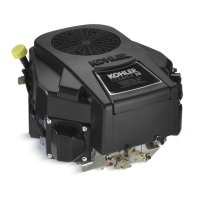
